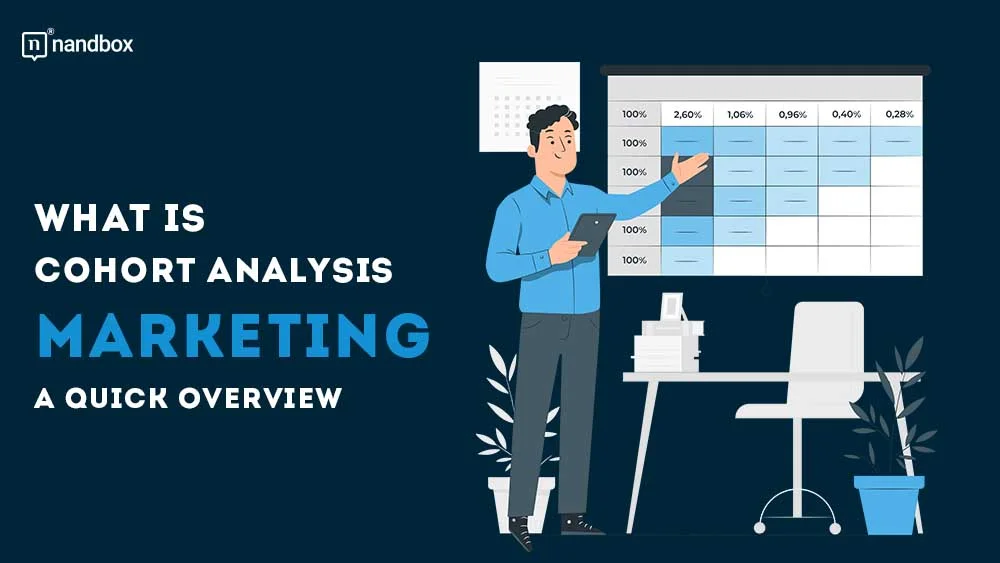Cohort Analysis Marketing: A Complete Guide
“Behavior” is a word that means “the way one acts or conducts oneself, especially towards others.” What does that have to do with our topic? Let us tell you. “Cohort analysis” is a marketing technique that allows you to track and analyze the behavior of a specific group of customers over time. By understanding how these customers interact with your app or brand in general, you can make more personalized and informed decisions about your marketing strategy. Additionally, you can improve your overall business performance. In this complete guide, we’ll explore the benefits of cohort analysis marketing and provide you with step-by-step instructions on how to use it effectively.
The long-term viability of a business depends not just on attracting new clients but also, in large part, on keeping those clients happy and giving them experiences that are tailored to their needs. Business analytics are increasingly being used to gain valuable insights from the vast amounts of data created by the operations and sales of businesses in order to increase profits and improve customer satisfaction. This is where cohort analysis comes into play and aids in giving clients a much more targeted experience.
What Is Cohort Analysis Marketing?
Cohort analysis is a marketing technique that involves grouping customers based on a shared characteristic or behavior. Furthermore, it allows you to track their behavior over time. This allows you to see how different groups of customers interact with your app or brand and how their behavior changes over time. Cohort analysis can be used to identify trends, track customer retention, and improve your marketing strategy. It is a powerful tool that can help you strengthen your marketing strategies and empower your business effectively.
Cohort Analysis vs. Cohort Data Studies
It is important to distinguish between cohort analysis and cohort studies, which divide data into comparable groups. In cohort analysis, however, business analytics and big data are the subjects of the analysis. Another use of cohort analysis is measuring user engagement over time. The analysis uses data from a specific eCommerce platform, web application, or online game to segment consumers into groups that have a common interest rather than viewing all users as a single entity.
For instance, cohort analysis enables a marketing manager to comprehend that clients who signed up for a product following a product demo had a higher retention rate than those who chose not to take part in the demo. Any department, including marketing, human resources, sales, and even healthcare, can use cohort analysis. For greater retention and lower churn rates, marketers could design tailored campaigns. The HR teams can confirm whether or not their methods and training are effective.
Why Is Cohort Analysis Important for Your Marketing Strategy?
Cohort analysis is important for your marketing strategy because it allows you to understand how different groups of customers behave over time. By grouping customers based on a shared characteristic or behavior, you can see how their behavior changes over time and identify trends that can add more value to your marketing strategy. For example, as we mentioned above, you may find that customers who make their first purchase during a certain time period are more likely to become repeat customers than those who make their first purchase at a different time. This information can help you target your marketing efforts more effectively and improve customer retention.
Types of Cohort Analysis in Marketing
There are two main types that we will be discussing in this article:
- Acquisition cohort analysis
- Behavioral cohort analysis
Let’s discover what these two types are, what they mean, and how they can be implemented or used.
Acquisition-Based Cohort Analysis in Marketing
When a customer first buys your product or when your brand first attracts customers, acquisition-based cohort analysis keeps track of trends and patterns in their behavior. For instance, if a sustainable food company releases a mobile app, you may choose to monitor patterns in user behavior at the time of the app’s initial download. Then, you can have various cohorts for every week or every month.
Additionally, you may examine which cohorts have the highest levels of engagement by measuring each cohort’s acquisition, conversion, and retention rates. You can even simulate related techniques among cohorts. As a result, you might observe that customers who downloaded your app in December had the highest conversion rates. This can imply that your marketing initiatives during that month were effective and could be carried out again.
Behavioral-Based Cohort Analysis in Marketing
This type of marketing technique focuses on observing cohort behaviors following a certain action, like buying your goods or simply checking out your app’s services and interacting with them in a certain way. Cohorts can be organized here based on when they made their initial purchase. To determine which user cohort is the most engaged, you can track data like average purchase value, attrition rate, customer lifetime value, and purchase rate.
You may observe, for example, that customers who purchased your goods in February made the largest purchases, which suggests that they are more likely to be devoted or active customers. Or, an e-commerce business can verify how various user groups act after adding things to their carts but making no purchases. Then, you may keep tabs on statistics like how long they stayed on the website and the rate of cart abandonment.
This can assist you in figuring out why visitors to the website browse around but don’t make any purchases. Additionally, this might also help you develop targeted marketing campaigns or strategies to turn them into paying clients.
Which Is Better to Use From Both Types?
Which type of cohort analysis is more effective? Simply put, that depends on the objectives of your analysis. Acquisition-based cohort analysis is the best option if you want to increase user acquisition rates and monitor the efficiency of different marketing channels. However, behavioral cohorts will be useful if you want to comprehend the numerous strategies for boosting customer retention and income. So it is actually up to you and your business goals and objectives. Make up your mind on which one will help you achieve your data goal and strengthen your marketing strategy.
Benefits of Cohort Analysis Marketing
There are many benefits to applying this technique to your marketing strategy. Here’s a list of what it can do and how it will enhance your marketing campaigns:
- Measures for you the impact of changes by helping you know if a certain app feature that you have just added has helped increase your sales or not.
- Maximize your market efforts: Customers recruited by sponsored advertisements have a higher retention rate than any other stream, according to cohort data. You can allocate your budget effectively with this information. On the other hand, if you discover that clients gained through social media channels churn more quickly than those acquired through other channels, you might want to look into the matter and raise retention rates.
How to Conduct a Cohort Analysis
Conducting a cohort analysis involves several steps. First, you need to define the cohort you want to analyze. This could be based on a variety of factors, such as the month a customer made their first purchase or the marketing channel they came from. Next, you need to gather data on the behavior of each cohort over time. This could include metrics such as retention rate, average order value, or lifetime value. Finally, you need to analyze the data to identify trends and insights that can inform your marketing strategy. This may involve creating visualizations or running statistical tests to determine the significance of any observed differences between cohorts.
Analyzing Cohort Data and Identifying Trends
Once you have gathered and organized your cohort data, it’s time to analyze it and identify trends. Making a cohort retention curve, which displays the proportion of consumers from each cohort who continue to be active over time, is one popular strategy. This can help you identify which cohorts are most valuable and which may need additional attention to improve retention. You can also compare metrics such as average order value or lifetime value between cohorts to identify any significant differences. By analyzing cohort data, you can gain valuable insights into your customers’ behavior and use this information to improve your marketing strategy.
Using Cohort Analysis to Improve Your Marketing Strategy
What is better than using a powerful tool that can help you understand your customers’ behavior and improve your marketing strategy? Believe me, nothing. Cohort analysis and marketing techniques can do that. By grouping customers based on shared characteristics such as acquisition date or behavior, you can track their behavior over time and identify trends. This can help you make data-driven decisions about how to allocate resources and improve customer retention. To get started with cohort analysis, you’ll need to gather and organize your data, choose your cohort criteria, and analyze the results. With the right approach, cohort analysis can be a valuable addition to your marketing toolkit.
Final Thoughts on the Topic
Conducting the right analysis and choosing the right marketing techniques and strategies is exactly what your business needs to get boosted and have your brand known in the market. That is why we advise you to develop your own native no-code application through nandbox’s native no-code app builder. Our app builder is currently the only native no-code app builder on the market that enables you to create native apps that are compatible with both iOS and Android systems.
With nandbox, you can build a seamless app that will impress the market with its capabilities within minutes. You don’t need any prior knowledge of programming or coding languages because all you have to do is simply drag and drop all your desired features in order to add them to your app-building window. Our app builder also has a fully detailed documentation section that will allow you to understand how to navigate it properly. Moreover, it will help you understand all the app builder’s features and modules and how to configure them with simple steps in your app.
Sign up now for nandbox’s native no-code app builder and enjoy our 14-day free trial that will allow you to understand and familiarize yourself with all the app development processes.








